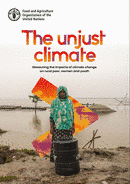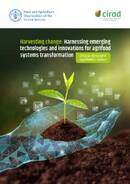Publications
Developing policies to foster inclusive rural transformation processes requires better evidence on how climate change is affecting the livelihoods and economic behaviours of vulnerable rural people, including women, youths and people living in poverty. In particular, there is little comparative, multi-country and multi-region evidence to understand how exposure to weather shocks and climate change affects the drivers of rural transformation and adaptive actions across different segments of rural societies and in different agro-ecological contexts. This evidence is essential because, while climate risk and adaptive actions are context specific and require local solutions, global evidence is important for identifying shared vulnerabilities and priority actions for scaling up effective responses.
This report assembles an impressive set of data from 24 low- and middle-income countries in five world regions to measure the effects of climate change on rural women, youths and people living in poverty. It analyses socioeconomic data collected from 109 341 rural households (representing over 950 million rural people) in these 24 countries. These data are combined in both space and time with 70 years of georeferenced data on daily precipitation and temperatures. The data enable us to disentangle how different types of climate stressors affect people’s on-farm, off-farm and total incomes, labour allocations and adaptive actions, depending on their wealth, gender and age characteristics.
This first report on FAO’s contribution to the global response to AMR outlines a wide range of activities undertaken by FAO at global, regional and country level. This report: describes FAO’s role in the global governance of AMR; provides an overview of progress on implementing national action plans on AMR in agrifood systems; and flags key challenges and opportunities related to AMR in the food and agriculture sectors.
This publication offers a synthesis of the major factors at play in the global food and agricultural landscape. Statistics are presented in four thematic chapters, covering the economic importance of agricultural activities, inputs, outputs and factors of production, their implications for food security and nutrition and their impacts on the environment. The Yearbook is meant to constitute a primary tool for policymakers, researchers and analysts, as well as the general public interested in the past, present and future path of food and agriculture.
The study assesses a selection of technologies and innovations, which potentially could be of paramount importance in addressing agrifood challenges until 2050, as well as the most important trends and drivers that will influence the emergence of agrifood technologies and innovations and their triggers of change, including some regional aspects. The goal is also to build plausible future scenarios for the evolvement of the emerging technologies and innovations in the future with the time horizon of 2050 to inform future-oriented policymaking.
Unveiled at the United Nations Climate Conference COP28, the Global Roadmap for Achieving Sustainable Development Goal 2 (SDG2) without Breaching the 1.5°C Threshold outlines a comprehensive strategy spanning the next three years that encompasses a diverse portfolio of solutions across ten distinct domains of action.
The roadmap calls for a transformative shift in agrifood systems. It challenges the prevailing narrative that increasing production is synonymous with higher emissions and environmental degradation. Instead, it emphasizes the opportunity within agrifood systems to enhance production efficiency while aligning with climate mitigation, adaptation, and resilience objectives, identifiying 120 actions and key milestones within ten domains, supported by evidence gathered by FAO. These domains include clean energy, crops, fisheries and aquaculture, food loss and waste, forests and wetlands, healthy diets, livestock, soil and water, and data and inclusive policies — the latter two identified as overall systemic enablers.






